Alexandra Sokoloff's Blog - Posts Tagged "how-to-write-a-screenplay"
Screenwriting Tricks for Authors: THE MASTER LIST
by Alexandra Sokoloff
I’m very excited to be teaching one of the writing Master Classes for the Bloody Scotland crime writing festival next month, along with the brilliant Denise Mina, one of my all-time favorite authors and a major inspiration for my Huntress Moon thrillers.
I always like to give my workshop students some optional homework in the weeks before classes, so that we get the most out of our workshop time – and also so that those of you who can’t make the workshop can play along at home!
What I teach in my Screenwriting Tricks for Authors workshops is basic film story structure: the Three-Act, Eight-Sequence structure.
USC film school teaches it, the screenwriting story structure gurus teach it, all film execs and producers are aware of it even if it’s only in a vague way, and even screenwriters who claim not to follow this structure pattern do it to some extent or another. And it translates beautifully to novel writing. Not only does it make writing novels much easier – this is a rhythm of storytelling that readers (and audiences) are so used to that if you aren't using it to your advantage, they’re going to feel like something’s missing! You don’t want that to happen.
But I want my students to analyze examples that are meaningful to them, so the first assignment I give my workshop students is THE MASTER LIST: a list of ten novels and films that are specific to the story and genre you’re working on, and more importantly, that have had the maximum emotional and intellectual effect on you.
> ASSIGNMENT: List ten books and films that are similar to your own story in structure and/or genre (at least five books and three movies if you’re writing a book, at least five movies if you’re writing a script.).
Or if you’re trying to decide on the right project for you to work on, then make a list of ten books and films that you wish you had written!
And you people who feel like you’ve done this for me already – remember that it’s good practice to make a master list for every new project you’re working on! Your lists will be different for different books.
It’s very simple: in order to write stories like the ones that move you, you need to look at the stories that affect you and figure out what those authors and filmmakers are doing to get the effect they do.
Every genre has its own structural patterns and its own tricks. Screenwriter Ryan Rowe says it perfectly: “Every genre has its own game that it’s playing with the audience.”
For example, with a mystery, the game is “Whodunit?” You are going to toy with a reader or audience’s expectations and lead them down all kinds of false paths with red herrings so that they are constantly in the shoes of the hero/ine, trying to figure the puzzle out.
But with a romantic comedy or classic romance, there’s no mystery involved. 99.99% of the time the hero and heroine are going to end up together. The game in that genre is often to show, through the hero and heroine, how we are almost always our own worst enemies in love, and how we throw up all kinds of obstacles in our own paths to keep ourselves from getting what we want.
So if you’re writing a story like It’s A Wonderful Life, it’s not going to help you much to study Apocalypse Now. A story that ends with a fallen hero/ine is not going to have the same story shape as one that ends with a transcended hero/ine. (Although if both kinds of films end up on your list of favorite stories, you might find one is the other in reverse. That’s why you need to make your own lists!)
Once you start looking at the games that genres play, you will also start to understand the games that you most love, and that you want to play with your readers and audience.
I’m primarily a thriller writer, and my personal favorite game is: “Is it supernatural or is it psychological?” I love to walk the line between the real and unreal, so I am constantly creating story situations in which there are multiple plausible explanations for the weird stuff that’s going on, including mental illness, drug-induced hallucinations, and outright fraud. That’s why my master list for any book or script I write will almost always include The Haunting of Hill House and The Shining, both classic books (and films) that walk the line between the supernatural and the psychological.
But what works for me structurally is not necessarily going to do it for you.
If you take the time to study and analyze the books and films that have had the greatest impact on you, personally, or that are structurally similar to the story you’re writing, or both, that’s when you really start to master your craft. Making the lists and analyzing those stories will help you brainstorm your own unique versions of scenes and meta-structures that work in the stories on your master list; it will help you figure out how your particular story will work. And doing this analysis will embed story structure in your head so that constructing a story becomes a fun and natural process for you.
Another great benefit of making the master list is that it helps you “brand” yourself as an author. Agents, editors, publishing houses, publicists, sales reps, bookstores, reviewers, media interviewers, librarians, and most importantly, your readers — all of these people want to be able to categorize you and your books. You need to be able to tell all of these people exactly what it is you write, what it’s similar to, and why it’s also unique. That’s part of your job as a professional author.
Remember, the list isn’t written in stone! You can change anything on it at any time. And honestly, when you’re doing these lists, it’s often most useful to write the first ten films and books that come to mind. Doing it fast and without thinking about it too consciously might show you something you never realized about what you’re writing.
And I encourage you to splurge on a nice big beautiful notebook to work in. We writers live so much in our heads it’s important to give ourselves toys and rewards to make the work feel less like work, and also to cut down on the drinking.
Do your list, and share it in the comments if you feel like it – next post we’ll be analyzing the lists!
- Alex
All the material from my workshops and on this blog, and much much more is available in my workbooks: $3.99 ebook, $14.99 print textbook:
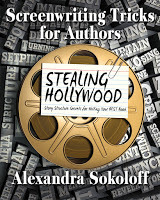 Print book US
Print book US
Print book all countries
e book
Enter to win a copy of the book!
You can sign up for my mailing list to get free breakdowns of The Silence of the Lambs, The Wizard of Oz, Chinatown, and other classic movies as I analyze them for my students and blog readers.
I’m very excited to be teaching one of the writing Master Classes for the Bloody Scotland crime writing festival next month, along with the brilliant Denise Mina, one of my all-time favorite authors and a major inspiration for my Huntress Moon thrillers.
I always like to give my workshop students some optional homework in the weeks before classes, so that we get the most out of our workshop time – and also so that those of you who can’t make the workshop can play along at home!
What I teach in my Screenwriting Tricks for Authors workshops is basic film story structure: the Three-Act, Eight-Sequence structure.
USC film school teaches it, the screenwriting story structure gurus teach it, all film execs and producers are aware of it even if it’s only in a vague way, and even screenwriters who claim not to follow this structure pattern do it to some extent or another. And it translates beautifully to novel writing. Not only does it make writing novels much easier – this is a rhythm of storytelling that readers (and audiences) are so used to that if you aren't using it to your advantage, they’re going to feel like something’s missing! You don’t want that to happen.
But I want my students to analyze examples that are meaningful to them, so the first assignment I give my workshop students is THE MASTER LIST: a list of ten novels and films that are specific to the story and genre you’re working on, and more importantly, that have had the maximum emotional and intellectual effect on you.
> ASSIGNMENT: List ten books and films that are similar to your own story in structure and/or genre (at least five books and three movies if you’re writing a book, at least five movies if you’re writing a script.).
Or if you’re trying to decide on the right project for you to work on, then make a list of ten books and films that you wish you had written!
And you people who feel like you’ve done this for me already – remember that it’s good practice to make a master list for every new project you’re working on! Your lists will be different for different books.
It’s very simple: in order to write stories like the ones that move you, you need to look at the stories that affect you and figure out what those authors and filmmakers are doing to get the effect they do.
Every genre has its own structural patterns and its own tricks. Screenwriter Ryan Rowe says it perfectly: “Every genre has its own game that it’s playing with the audience.”
For example, with a mystery, the game is “Whodunit?” You are going to toy with a reader or audience’s expectations and lead them down all kinds of false paths with red herrings so that they are constantly in the shoes of the hero/ine, trying to figure the puzzle out.
But with a romantic comedy or classic romance, there’s no mystery involved. 99.99% of the time the hero and heroine are going to end up together. The game in that genre is often to show, through the hero and heroine, how we are almost always our own worst enemies in love, and how we throw up all kinds of obstacles in our own paths to keep ourselves from getting what we want.
So if you’re writing a story like It’s A Wonderful Life, it’s not going to help you much to study Apocalypse Now. A story that ends with a fallen hero/ine is not going to have the same story shape as one that ends with a transcended hero/ine. (Although if both kinds of films end up on your list of favorite stories, you might find one is the other in reverse. That’s why you need to make your own lists!)
Once you start looking at the games that genres play, you will also start to understand the games that you most love, and that you want to play with your readers and audience.
I’m primarily a thriller writer, and my personal favorite game is: “Is it supernatural or is it psychological?” I love to walk the line between the real and unreal, so I am constantly creating story situations in which there are multiple plausible explanations for the weird stuff that’s going on, including mental illness, drug-induced hallucinations, and outright fraud. That’s why my master list for any book or script I write will almost always include The Haunting of Hill House and The Shining, both classic books (and films) that walk the line between the supernatural and the psychological.
But what works for me structurally is not necessarily going to do it for you.
If you take the time to study and analyze the books and films that have had the greatest impact on you, personally, or that are structurally similar to the story you’re writing, or both, that’s when you really start to master your craft. Making the lists and analyzing those stories will help you brainstorm your own unique versions of scenes and meta-structures that work in the stories on your master list; it will help you figure out how your particular story will work. And doing this analysis will embed story structure in your head so that constructing a story becomes a fun and natural process for you.
Another great benefit of making the master list is that it helps you “brand” yourself as an author. Agents, editors, publishing houses, publicists, sales reps, bookstores, reviewers, media interviewers, librarians, and most importantly, your readers — all of these people want to be able to categorize you and your books. You need to be able to tell all of these people exactly what it is you write, what it’s similar to, and why it’s also unique. That’s part of your job as a professional author.
Remember, the list isn’t written in stone! You can change anything on it at any time. And honestly, when you’re doing these lists, it’s often most useful to write the first ten films and books that come to mind. Doing it fast and without thinking about it too consciously might show you something you never realized about what you’re writing.
And I encourage you to splurge on a nice big beautiful notebook to work in. We writers live so much in our heads it’s important to give ourselves toys and rewards to make the work feel less like work, and also to cut down on the drinking.
Do your list, and share it in the comments if you feel like it – next post we’ll be analyzing the lists!
- Alex
All the material from my workshops and on this blog, and much much more is available in my workbooks: $3.99 ebook, $14.99 print textbook:
 Print book US
Print book USPrint book all countries
e book
Enter to win a copy of the book!
You can sign up for my mailing list to get free breakdowns of The Silence of the Lambs, The Wizard of Oz, Chinatown, and other classic movies as I analyze them for my students and blog readers.
Published on August 17, 2015 04:46
•
Tags:
editing, how-to-write-a-screenplay, screenwriting, story-structure, writing-books, writing-your-novel
Nanowrimo Prep: What's your PREMISE?
So you've had some time to ponder the question of What is a Good Story Idea?
Today we're going to talk about PREMISE (again), because what we really need to start looking for in all the brainstorming you did is actual STORY LINES.
And it's possible that the best way to recognize stories in your own ideas (that is, STORIES, as opposed to IDEAS) - is to do some practice on PREMISE.
Get free Story Structure extras and movie breakdowns
One of the most frustrating (and sometimes amusing, in a morbid kind of way) things for me as an author and teacher is how difficult it can be sometimes to get a writer's story out of them.
It should be simple, right - to answer the question: “What’s your book about?”
But writers who are used to being in the thick of writing sometimes have only the vaguest idea of the big picture.
So the conversation often goes like this:
Me: "What's your book about?"
Aspiring author: “Oh, I can’t really describe it in a few sentences – there’s just so much going on in it.”
Worse - these conversations often happen at conferences where aspiring writers are being equally vague if they happen to be lucky enough to get into a conversation with an agent or editor.
(On the other hand, I was thrilled to have so many people who've read my books and follow this blog come up to me at RWA Denver and pitch me their perfectly honed and commercial premises!)
The time to know what your book is about is before you start it, and you damn well better know what it’s about by the time it’s finished and people, like agents and editors are asking you what it’s about.
You will learn a lot more about what your book or film is about as you're writing it. But you need to know what you think it's about before you start that draft.
And here’s another tip – when people ask you what your book is about, the answer is not “War” or “Love” or “Betrayal”, even though your book might be about one or all of those things. Those words don’t distinguish YOUR book from any of the millions of books about those things.
When people ask you what your book is about, what they are really asking is – “What’s the premise?” In other words, “What’s the story line in one easily understandable sentence?”
That one sentence is also referred to as a “logline” (in Hollywood) or “the elevator pitch” (in publishing) or “the TV Guide pitch” – it all means the same thing.
That sentence really should give you a sense of the entire story: the character of the protagonist, the character of the antagonist, the conflict, the setting, the tone, the genre. And – it should make whoever hears it want to read the book. Preferably immediately. It should make the person you tell it to light up and say – “Ooh, that sounds great!” And “Where do I buy it?”
Writing a premise sentence is a bit of an art, but it’s a critical art for authors, and screenwriters, and playwrights. You need to do this well to sell a book, to pitch a movie, to apply for a grant. You will need to do it well when your agent, and your publicist, and the sales department of your publishing house, and the reference librarian, and the Sisters in Crime books in print catalogue editor, and that Amazon KDP screen asks you for a one-sentence book description, or jacket copy, or ad copy. You will use that sentence over and over and over again in radio and TV interviews, on panels, and in bookstores (over and over and OVER again) when potential readers ask you, “So what’s your book about?” and you have about one minute to get them hooked enough to buy the book.
And even before all that, the premise is the map of your book when you’re writing it.
So what are some examples of premise lines?
Name these books/films:
- When a great white shark starts attacking beachgoers in a coastal town during high tourist season, a water-phobic Sheriff must assemble a team to hunt it down before it kills again.
- A young female FBI trainee must barter personal information with an imprisoned psychopathic genius in order to catch a serial killer who is capturing and killing young women for their skins.
- A treasure-hunting archeologist races over the globe to find the legendary Lost Ark of the Covenant before Hitler’s minions can acquire and use it to supernaturally power the Nazi army.
Notice how all of these premises contain a defined protagonist, a powerful antagonist, a sense of the setting, conflict and stakes, and a sense of how the action will play out. Another interesting thing about these premises is that in all three, the protagonists are up against forces that seem much bigger than the protagonist.
Halloween is upon us, so here’s my premise for my ghost story THE HARROWING:
Five troubled college students left alone on their isolated campus over the long Thanksgiving break confront their own demons and a mysterious presence – that may or may not be real.
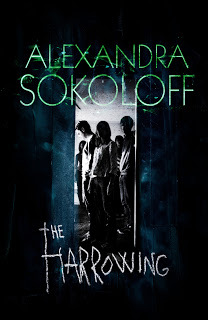 I wrote that sentence to quickly convey all the elements I want to get across about this book.
I wrote that sentence to quickly convey all the elements I want to get across about this book.
Who’s the story about? Five college kids, and “alone” and “troubled” characterize them in a couple of words. Not only are they alone and troubled, they have personal demons.
What’s the setting? An isolated college campus, and it’s Thanksgiving - fall, going on winter. Bleak, spooky. Plus – if it’s Thanksgiving, why are they on campus instead of home with their families?
Who’s the antagonist? A mysterious presence.
What’s the conflict? It’s inner and outer – it will be the kids against themselves, and also against this mysterious presence. What are the stakes? Well, not so clear, but there’s a sense of danger involved with any mysterious presence.
And there are a lot of Clues to the Genre – sounds like something supernatural’s going on, but there’s also a sense that it’s psychological – because the kids are troubled and this presence may or may not be real. There's a sense of danger, possibly on several levels.
And you can see how that premise sentence inspired one of the major planks of the selling campaign for that book (and any book) - the cover design, one of my favorites. (The UK edition, from Little Brown, the US edition, on Amazon.)
The best way to learn how to write a good premise is to practice. Take that list of ten books and films I made you do here, that are in the same genre as your book or script - preferably successful - or that you wish you had written! Now for each story on that list, write a one-sentence premise that contains all these story elements: protagonist, antagonist, conflict, stakes, setting, atmosphere and genre.
If you need a lot of examples all at once, pick up a copy of the TV Guide, or click through the descriptions of movies on your TiVo. Those aren’t necessarily the best written premises, but they do get the point across, and it will get you thinking about stories in brief.
So there are three exercises I'd like to suggest for you to try.
1) Take your master list of ten books and films and write a premise sentence for each. Share a few here if you care to - it will help other people and that's good karma!
2) Write your OWN premise, for your WIP or potential project.
Be sure your premise includes
Who's the story about?
What’s the setting?
Who’s the antagonist?
What’s the conflict?
Clues to the genre
And 3) harder, but really, really worth it - look at your mass (or mess) of brainstormed ideas and see if you can pull and/or create ten (oh, all right, five) complete premises out of that list.
Or do three this week, three next week, three the next...
And that third option is something I'm saying TO MAKE MYSELF DO IT, too, so no whining about how I've completely gone off the deep end. I have, of course - but I also think the story ideas that would come out of really taking that last exercise seriously would raise anyone's writing to the next level. And perhaps yield something exciting and HIGH CONCEPT.
But if you're not familiar with writing premise lines, the most important exercise for you right now is 1) - write the premise sentences for your own master list. It's like doing piano scales. Repetition is the mother of skill.
- Alex
=====================================================
All the information on this blog and more, including full story structure breakdowns of various movies, is available in my Screenwriting Tricks for Authors workbooks. e format, just $3.99 and $2.99; print 13.99.
STEALING HOLLYWOOD
This new workbook updates all the text in the first Screenwriting Tricks for Authors ebook with all the many tricks I’ve learned over my last few years of writing and teaching—and doubles the material of the first book, as well as adding six more full story breakdowns.
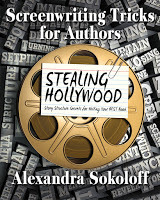
STEALING HOLLYWOOD ebook $3.99
STEALING HOLLYWOOD US print $14.99
STEALING HOLLYWOOD print, all countries
WRITING LOVE
Writing Love is a shorter version of the workbook, using examples from love stories, romantic suspense, and romantic comedy - available in e formats for just $2.99.
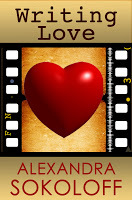 - Smashwords (includes online viewing and pdf file)
- Smashwords (includes online viewing and pdf file)
- Amazon/Kindle
- Barnes & Noble/Nook
- Amazon UK
- Amazon DE
---------------------
You can also sign up to get free movie breakdowns here:
Get free Story Structure extras and movie breakdowns
Today we're going to talk about PREMISE (again), because what we really need to start looking for in all the brainstorming you did is actual STORY LINES.
And it's possible that the best way to recognize stories in your own ideas (that is, STORIES, as opposed to IDEAS) - is to do some practice on PREMISE.
Get free Story Structure extras and movie breakdowns
One of the most frustrating (and sometimes amusing, in a morbid kind of way) things for me as an author and teacher is how difficult it can be sometimes to get a writer's story out of them.
It should be simple, right - to answer the question: “What’s your book about?”
But writers who are used to being in the thick of writing sometimes have only the vaguest idea of the big picture.
So the conversation often goes like this:
Me: "What's your book about?"
Aspiring author: “Oh, I can’t really describe it in a few sentences – there’s just so much going on in it.”
Worse - these conversations often happen at conferences where aspiring writers are being equally vague if they happen to be lucky enough to get into a conversation with an agent or editor.
(On the other hand, I was thrilled to have so many people who've read my books and follow this blog come up to me at RWA Denver and pitch me their perfectly honed and commercial premises!)
The time to know what your book is about is before you start it, and you damn well better know what it’s about by the time it’s finished and people, like agents and editors are asking you what it’s about.
You will learn a lot more about what your book or film is about as you're writing it. But you need to know what you think it's about before you start that draft.
And here’s another tip – when people ask you what your book is about, the answer is not “War” or “Love” or “Betrayal”, even though your book might be about one or all of those things. Those words don’t distinguish YOUR book from any of the millions of books about those things.
When people ask you what your book is about, what they are really asking is – “What’s the premise?” In other words, “What’s the story line in one easily understandable sentence?”
That one sentence is also referred to as a “logline” (in Hollywood) or “the elevator pitch” (in publishing) or “the TV Guide pitch” – it all means the same thing.
That sentence really should give you a sense of the entire story: the character of the protagonist, the character of the antagonist, the conflict, the setting, the tone, the genre. And – it should make whoever hears it want to read the book. Preferably immediately. It should make the person you tell it to light up and say – “Ooh, that sounds great!” And “Where do I buy it?”
Writing a premise sentence is a bit of an art, but it’s a critical art for authors, and screenwriters, and playwrights. You need to do this well to sell a book, to pitch a movie, to apply for a grant. You will need to do it well when your agent, and your publicist, and the sales department of your publishing house, and the reference librarian, and the Sisters in Crime books in print catalogue editor, and that Amazon KDP screen asks you for a one-sentence book description, or jacket copy, or ad copy. You will use that sentence over and over and over again in radio and TV interviews, on panels, and in bookstores (over and over and OVER again) when potential readers ask you, “So what’s your book about?” and you have about one minute to get them hooked enough to buy the book.
And even before all that, the premise is the map of your book when you’re writing it.
So what are some examples of premise lines?
Name these books/films:
- When a great white shark starts attacking beachgoers in a coastal town during high tourist season, a water-phobic Sheriff must assemble a team to hunt it down before it kills again.
- A young female FBI trainee must barter personal information with an imprisoned psychopathic genius in order to catch a serial killer who is capturing and killing young women for their skins.
- A treasure-hunting archeologist races over the globe to find the legendary Lost Ark of the Covenant before Hitler’s minions can acquire and use it to supernaturally power the Nazi army.
Notice how all of these premises contain a defined protagonist, a powerful antagonist, a sense of the setting, conflict and stakes, and a sense of how the action will play out. Another interesting thing about these premises is that in all three, the protagonists are up against forces that seem much bigger than the protagonist.
Halloween is upon us, so here’s my premise for my ghost story THE HARROWING:
Five troubled college students left alone on their isolated campus over the long Thanksgiving break confront their own demons and a mysterious presence – that may or may not be real.
 I wrote that sentence to quickly convey all the elements I want to get across about this book.
I wrote that sentence to quickly convey all the elements I want to get across about this book.Who’s the story about? Five college kids, and “alone” and “troubled” characterize them in a couple of words. Not only are they alone and troubled, they have personal demons.
What’s the setting? An isolated college campus, and it’s Thanksgiving - fall, going on winter. Bleak, spooky. Plus – if it’s Thanksgiving, why are they on campus instead of home with their families?
Who’s the antagonist? A mysterious presence.
What’s the conflict? It’s inner and outer – it will be the kids against themselves, and also against this mysterious presence. What are the stakes? Well, not so clear, but there’s a sense of danger involved with any mysterious presence.
And there are a lot of Clues to the Genre – sounds like something supernatural’s going on, but there’s also a sense that it’s psychological – because the kids are troubled and this presence may or may not be real. There's a sense of danger, possibly on several levels.
And you can see how that premise sentence inspired one of the major planks of the selling campaign for that book (and any book) - the cover design, one of my favorites. (The UK edition, from Little Brown, the US edition, on Amazon.)
The best way to learn how to write a good premise is to practice. Take that list of ten books and films I made you do here, that are in the same genre as your book or script - preferably successful - or that you wish you had written! Now for each story on that list, write a one-sentence premise that contains all these story elements: protagonist, antagonist, conflict, stakes, setting, atmosphere and genre.
If you need a lot of examples all at once, pick up a copy of the TV Guide, or click through the descriptions of movies on your TiVo. Those aren’t necessarily the best written premises, but they do get the point across, and it will get you thinking about stories in brief.
So there are three exercises I'd like to suggest for you to try.
1) Take your master list of ten books and films and write a premise sentence for each. Share a few here if you care to - it will help other people and that's good karma!
2) Write your OWN premise, for your WIP or potential project.
Be sure your premise includes
Who's the story about?
What’s the setting?
Who’s the antagonist?
What’s the conflict?
Clues to the genre
And 3) harder, but really, really worth it - look at your mass (or mess) of brainstormed ideas and see if you can pull and/or create ten (oh, all right, five) complete premises out of that list.
Or do three this week, three next week, three the next...
And that third option is something I'm saying TO MAKE MYSELF DO IT, too, so no whining about how I've completely gone off the deep end. I have, of course - but I also think the story ideas that would come out of really taking that last exercise seriously would raise anyone's writing to the next level. And perhaps yield something exciting and HIGH CONCEPT.
But if you're not familiar with writing premise lines, the most important exercise for you right now is 1) - write the premise sentences for your own master list. It's like doing piano scales. Repetition is the mother of skill.
- Alex
=====================================================
All the information on this blog and more, including full story structure breakdowns of various movies, is available in my Screenwriting Tricks for Authors workbooks. e format, just $3.99 and $2.99; print 13.99.
STEALING HOLLYWOOD
This new workbook updates all the text in the first Screenwriting Tricks for Authors ebook with all the many tricks I’ve learned over my last few years of writing and teaching—and doubles the material of the first book, as well as adding six more full story breakdowns.

STEALING HOLLYWOOD ebook $3.99
STEALING HOLLYWOOD US print $14.99
STEALING HOLLYWOOD print, all countries
WRITING LOVE
Writing Love is a shorter version of the workbook, using examples from love stories, romantic suspense, and romantic comedy - available in e formats for just $2.99.
 - Smashwords (includes online viewing and pdf file)
- Smashwords (includes online viewing and pdf file)- Amazon/Kindle
- Barnes & Noble/Nook
- Amazon UK
- Amazon DE
---------------------
You can also sign up to get free movie breakdowns here:
Get free Story Structure extras and movie breakdowns
Published on October 09, 2018 01:15
•
Tags:
alexandra-sokoloff, how-to-write-a-book, how-to-write-a-screenplay, nanowrimo, premise
Nanowrimo Prep: Brainstorm your book with index cards
THE INDEX CARD METHOD
by Alexandra Sokoloff
Two weeks to #Nanowrimo. Are you panicking because you have only the vaguest clue what you're writing about?
Here's a fun and lighting-fast brainstorming method that I absolutely guarantee will get you closer to understanding the story you want to write.
It's the number one structuring tool of most screenwriters I know. I have no idea how I would write without it.
Get free Story Structure extras and movie breakdowns
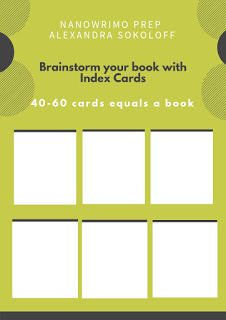 Get yourself a pack of index cards. You can also use Post-Its, and the truly OCD among us use colored Post-Its to identify various subplots by color, but I find having to make those kinds of decisions just fritzes my brain. I like cards because they’re more durable and I can spread them out on the floor for me to crawl around and for the cats to walk over; it somehow feels less like work that way. Everyone has their own method - experiment and find what works best for you.
Get yourself a pack of index cards. You can also use Post-Its, and the truly OCD among us use colored Post-Its to identify various subplots by color, but I find having to make those kinds of decisions just fritzes my brain. I like cards because they’re more durable and I can spread them out on the floor for me to crawl around and for the cats to walk over; it somehow feels less like work that way. Everyone has their own method - experiment and find what works best for you.
A movie has about 40 to 60 scenes (a drama more like 40, an action movie more like 60), every scene goes on one card. Now, if you’re structuring a novel this way, you may be doubling or tripling the scene count, but for me, the chapter count remains exactly the same: forty to sixty chapters to a book.
So count yourself out 40-60 index cards. That's your book! You can actually hold it in your hand. Pretty cool, right?
All you do at first is write down all the scenes you know about your story, one scene per card (just one or two lines describing each scene - it can be as simple as - "Hero and heroine meet" or - "Meet the antagonist".)
You don’t have to put them in order yet - that's the next post!
I love the cards because they are such an overview. You can stick a bunch of vaguely related scenes together in a clump, rearrange one or two, and suddenly see a perfect progression of an entire sequence. You can throw away cards that aren’t working, or make several cards with the same scene and try them in different parts of your story board (which we'll talk about next).
You will find it is often shockingly fast and simple to structure a whole story this way.
ASSIGNMENT:
-- Get a pack of index cards or Post Its and write down all the scenes you know about your story.
--------------------------------------------------------------------------------------------
All the information on this blog and more, including full story structure breakdowns of various movies, is available in the workbooks.:
This new workbook updates all the text in the first Screenwriting Tricks for Authors ebook with all the many tricks I’ve learned over my last few years of writing and teaching—and doubles the material of the first book, as well as adding six more full story breakdowns.

STEALING HOLLYWOOD ebook $3.99
STEALING HOLLYWOOD US print $14.99
STEALING HOLLYWOOD print, all countries
WRITING LOVE
Writing Love is a shorter version of the workbook, using examples from love stories, romantic suspense, and romantic comedy - available in e formats for just $2.99.
 - Smashwords (includes online viewing and pdf file)
- Smashwords (includes online viewing and pdf file)
- Amazon/Kindle
- Barnes & Noble/Nook
- Amazon UK
- Amazon DE
---------------------
You can also sign up to get free movie breakdowns here:
Get free Story Structure extras and movie breakdowns
Next up: The Story Grid
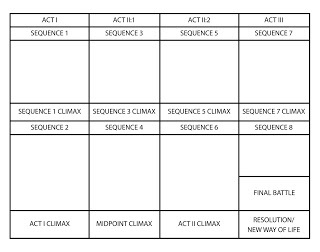
___________________________________________________________________
Huntress series sale, $1.99
Anyone up for some female vigilante justice?
All five books of my Thriller Award-nominated Huntress Moon series are on sale, just $1.99 each on Amazon US. The series turns tropes of violence against women inside out: my haunted FBI agent is on the hunt for a female serial killer. Who kills men. All over the country. For years.
So if you're in the mood to see the predators LOSE, here’s your chance to get a great deal.
Special Agent Matthew Roarke thought he knew what evil was. He was wrong.
Shop for all five here

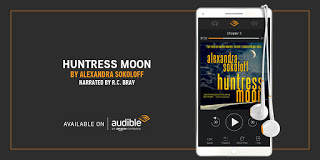 Huntress Moon - Audiobook
Huntress Moon - Audiobook
Voice Arts Award for Best Audiobook Narration
Audiobook junkies might want to take the sale opportunity to pick up the ebook - then add the narration for as low as $1.99.
Huntress Moon and my amazing narrator, RC Bray, won a Voice Arts Award for Best Audiobook Narration, Crime & Thriller.
Bob is also the multi-award-winning narrator of the blockbuster audiobook of The Martian, and you can hear his stellar narration in all five Huntress books.
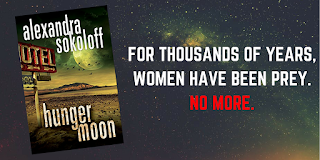
by Alexandra Sokoloff
Two weeks to #Nanowrimo. Are you panicking because you have only the vaguest clue what you're writing about?
Here's a fun and lighting-fast brainstorming method that I absolutely guarantee will get you closer to understanding the story you want to write.
It's the number one structuring tool of most screenwriters I know. I have no idea how I would write without it.
Get free Story Structure extras and movie breakdowns
 Get yourself a pack of index cards. You can also use Post-Its, and the truly OCD among us use colored Post-Its to identify various subplots by color, but I find having to make those kinds of decisions just fritzes my brain. I like cards because they’re more durable and I can spread them out on the floor for me to crawl around and for the cats to walk over; it somehow feels less like work that way. Everyone has their own method - experiment and find what works best for you.
Get yourself a pack of index cards. You can also use Post-Its, and the truly OCD among us use colored Post-Its to identify various subplots by color, but I find having to make those kinds of decisions just fritzes my brain. I like cards because they’re more durable and I can spread them out on the floor for me to crawl around and for the cats to walk over; it somehow feels less like work that way. Everyone has their own method - experiment and find what works best for you.A movie has about 40 to 60 scenes (a drama more like 40, an action movie more like 60), every scene goes on one card. Now, if you’re structuring a novel this way, you may be doubling or tripling the scene count, but for me, the chapter count remains exactly the same: forty to sixty chapters to a book.
So count yourself out 40-60 index cards. That's your book! You can actually hold it in your hand. Pretty cool, right?
All you do at first is write down all the scenes you know about your story, one scene per card (just one or two lines describing each scene - it can be as simple as - "Hero and heroine meet" or - "Meet the antagonist".)
You don’t have to put them in order yet - that's the next post!
I love the cards because they are such an overview. You can stick a bunch of vaguely related scenes together in a clump, rearrange one or two, and suddenly see a perfect progression of an entire sequence. You can throw away cards that aren’t working, or make several cards with the same scene and try them in different parts of your story board (which we'll talk about next).
You will find it is often shockingly fast and simple to structure a whole story this way.
ASSIGNMENT:
-- Get a pack of index cards or Post Its and write down all the scenes you know about your story.
--------------------------------------------------------------------------------------------
All the information on this blog and more, including full story structure breakdowns of various movies, is available in the workbooks.:
This new workbook updates all the text in the first Screenwriting Tricks for Authors ebook with all the many tricks I’ve learned over my last few years of writing and teaching—and doubles the material of the first book, as well as adding six more full story breakdowns.

STEALING HOLLYWOOD ebook $3.99
STEALING HOLLYWOOD US print $14.99
STEALING HOLLYWOOD print, all countries
WRITING LOVE
Writing Love is a shorter version of the workbook, using examples from love stories, romantic suspense, and romantic comedy - available in e formats for just $2.99.
 - Smashwords (includes online viewing and pdf file)
- Smashwords (includes online viewing and pdf file)- Amazon/Kindle
- Barnes & Noble/Nook
- Amazon UK
- Amazon DE
---------------------
You can also sign up to get free movie breakdowns here:
Get free Story Structure extras and movie breakdowns
Next up: The Story Grid

___________________________________________________________________
Huntress series sale, $1.99
Anyone up for some female vigilante justice?
All five books of my Thriller Award-nominated Huntress Moon series are on sale, just $1.99 each on Amazon US. The series turns tropes of violence against women inside out: my haunted FBI agent is on the hunt for a female serial killer. Who kills men. All over the country. For years.
So if you're in the mood to see the predators LOSE, here’s your chance to get a great deal.
Special Agent Matthew Roarke thought he knew what evil was. He was wrong.
Shop for all five here

 Huntress Moon - Audiobook
Huntress Moon - Audiobook Voice Arts Award for Best Audiobook Narration
Audiobook junkies might want to take the sale opportunity to pick up the ebook - then add the narration for as low as $1.99.
Huntress Moon and my amazing narrator, RC Bray, won a Voice Arts Award for Best Audiobook Narration, Crime & Thriller.
Bob is also the multi-award-winning narrator of the blockbuster audiobook of The Martian, and you can hear his stellar narration in all five Huntress books.

Published on October 16, 2018 00:48
•
Tags:
alexandra-sokoloff, how-to-write-a-book, how-to-write-a-screenplay, nanowrimo, nanowrimo-prep, stealing-hollywood



